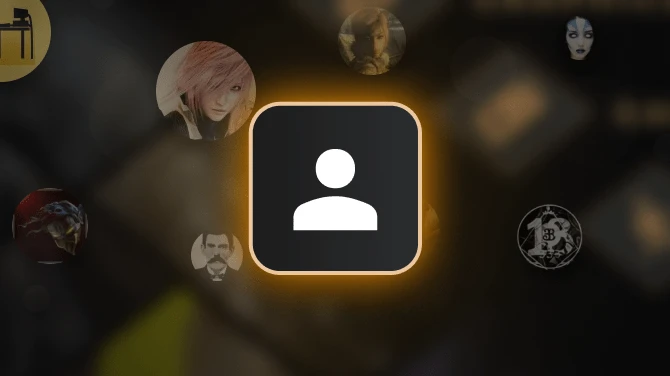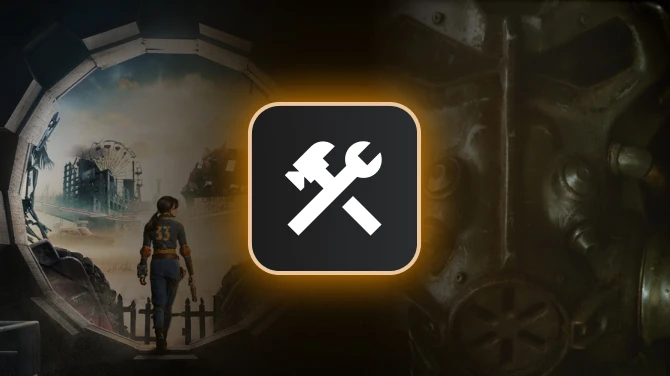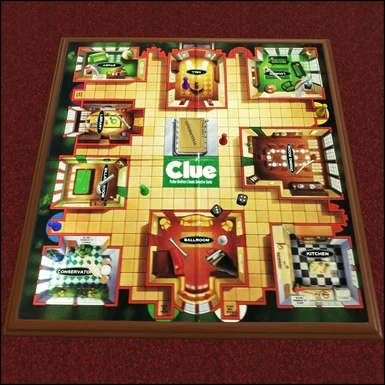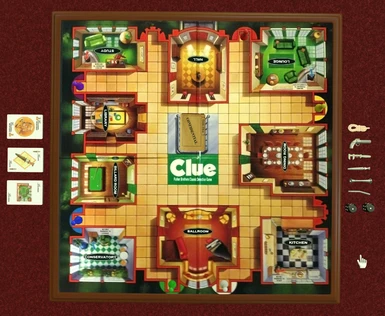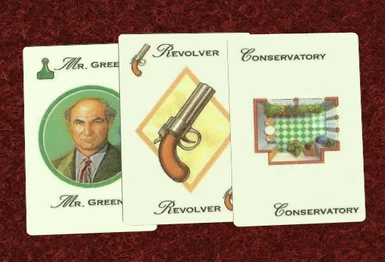About this mod
Clue (Cluedo) - 1996 version, Includes custom model weapons. 2-6 players.
Tabletop Simulator Specific instructions:
• Place the 'murder weapon', 'murder location', and 'murder suspect cards' between the two 'Case File' cards
• Take notes using Tabletop Simulator's 'Notepad'
- Permissions and credits
Tabletop Simulator Specific instructions:
• Place the 'murder weapon', 'murder location', and 'murder suspect cards' between the two 'Case File' cards
• Take notes using Tabletop Simulator's 'Notepad'
• Optional: Copy/Paste the following note into your private notepad for an easy checklist:
Suspects:
Miss Scarlet [ ]
Col. Mustard [ ]
Mrs. White [ ]
Mr. Green [ ]
Mrs. Peacock [ ]
Prof. Plum [ ]
Weapons:
Candlestick [ ]
Knife [ ]
Lead pipe [ ]
Revolver [ ]
Rope [ ]
Wrench [ ]
Rooms:
Kitchen [ ]
Ballroom [ ]
Conservatory [ ]
Dining Room [ ]
Billiard Room [ ]
Library [ ]
Lounge [ ]
Hall [ ]
Study [ ]
Rules:
At the beginning of play, three cards — one suspect, one weapon, and one room card — are chosen at random and put into a special envelope, so that no one can see them. These cards represent the facts of the case. The remainder of the cards are distributed among the players.
Players are instructed to assume the token/suspect nearest them. In older versions, play begins with Miss Scarlet and proceeds clockwise. In modern versions, all players roll the dice and the highest total starts the game and then proceeds clockwise. Players roll the dice (some versions contain one and others two) and move along the board's corridor spaces, or into the rooms accordingly.
The aim is to deduce the details of the murder; that is, the cards in the envelope. There are six characters, six murder weapons and nine rooms, leaving the players with 324 possibilities. While determining the details of the murder, players announce suggestions to the other players, for example:
"I suggest it was Mr. Green, in the Hall, with the revolver."
"I suggest it was Colonel Mustard, in the Conservatory, with the wrench"
"I suggest it was Professor Plum, in the Billiard Room, with the knife."
"I suggest it was Mrs. Peacock, in the Dining Room, with the Candlestick."
"I suggest it was Mrs. White, in the Library, with the Rope."
"I suggest it was Miss Scarlet, in the Kitchen, with the Lead Pipe."
The player's token must be in the room they suggest (in the preceding examples, it must be in either the Hall, the Conservatory, the Billiard Room, the Dining Room, the Library, or the Kitchen); suggestions may not be made in the corridors. The token and weapon suggested are moved into the room, if not already present.
The player to the left of the suggesting player must then disprove the suggestion, if they can, by showing the suggesting player one (and only one) of the cards containing one of the suggestion components (either the suspect, the weapon, or the room), as this proves that the card cannot be in the envelope. This is done in secret so that the other players cannot see which card is being used to disprove the suggestion. If a player has more than one such card, they may select which one to show. If the first player to the left of the suggesting player does not have any of the three cards needed to disprove the suggestion, the next player clockwise must disprove the suggestion, if possible, and so on clockwise until either the suggesting player is shown a card that disproves their suggestion, or each player advises that they can not disprove the suggestion. The suggesting player's turn then ends. The suggesting player does not advise the other players whether they hold any of the three cards.
Once a player has sufficiently narrowed the solution, that player can make an accusation. According to the rules, "When you think you have worked out which three cards are in the envelope, you may, on your turn, make an Accusation and name any three elements you want." Players may name any room (unlike a Suggestion, where a player's character pawn must be in the room that the player suggests).[9]
The accusing player checks the validity of the accusation by checking the cards, keeping them concealed from other players. If they've made an incorrect accusation, they play no further part in the game except to reveal cards secretly to one of the remaining players when required to do so to disprove suggestions. Also, according to the rules, "If, after making a false Accusation, your character pawn is blocking a door, [you must] move it into that room so that other players may enter." If the player made a correct accusation, the solution cards are shown to the other players and the game ends.
A player can use the piece representing the murderer. This does not affect the game play; the object of the game is still to be the first to make the correct accusation. All editions of the current version of the game are advertised as a three to six player game only. Traditionally, the UK version was advertised for two to six players.






